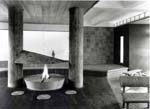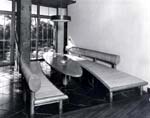

Home Site Search Contact Us Subscribe
|
|
|
|
The Noguchi Room at Keio University: Saved or Destroyed?
by ArchNewsNow July 15, 2003 Despite a lawsuit in Japan
and international protest, Tokyo’s Keio University has proceeded with the
dismantling of Shin Banraisha, also called The Noguchi Room, on the
university’s Mita Campus. Considered a masterpiece of post-war art and
architecture, the faculty room and sculpture garden was designed in 1952 by
Isamu Noguchi in honor of his father, a prominent Japanese poet and instructor
at the university. The artist worked in collaboration with Yoshirō
Taniguchi, architect of the Shin Banraisha, or “New Building of Welcome”
(and father of Yoshio Taniguchi, architect of The Museum of Modern Art’s
renovation project currently under construction in New York City). The unsuccessful lawsuit to
keep the work in situ, along with strong protests by several
organizations that included the Noguchi Foundations in New York and Japan, the
International Committee to Preserve Shin Banraisha (a consortium of
arts, architecture, and preservation professionals), and professors at Keio,
attempted to block what was regarded as nothing less than the destruction of
the work. According to its website,
Keio University sees it more as preservation of “the most culturally and
historically important parts of the Banraisha,” and plans to re-install
the room and garden on the third-floor roof terrace of a new Law School building (the link includes an image of the
proposed building, but no architectural attribution). Isaac Shapiro, President of
the Isamu Noguchi Foundation,
stated in a release last week, “The Foundation in New York was deeply saddened
to learn that Keio University had destroyed Shin
Banraisha, the internationally acclaimed artwork on its main campus in
Tokyo. The site-specific work, with its extraordinary faculty room and garden,
had long been considered a milestone in 20th-century Japanese cultural life.
The Foundation repeatedly articulated to the University its position that to
alter Shin Banraisha in any manner
would be to destroy it. As a site-specific work of art, relocating or
attempting to recreate it elsewhere, as the University is now proposing, would
inevitably change its original concept as well as the relationships of its
components, which were carefully created by the artist and essential to the
contemplative nature of the room and garden. The destruction of Shin Banraisha is a loss not only to the
students and faculty of Keio University and the Japanese public, but also to
the international cultural community.” Shoji Sadao, architect and
Trustee and former Executive Director of the Isamu Noguchi Foundation in the
United States, commented, “Keio University’s actions have deprived Tokyo’s
urban landscape of a unique haven of tranquility and incomparable beauty. We
are inestimably disappointed that the University, an institution dedicated to
instilling in its students a respect for creative effort, has not fulfilled its
public trust and preserved what is unquestionably one of the most important
structures on its campus.” According to the release,
The Noguchi Room, together with the contiguous sculpture garden, is regarded by
many as a milestone in the history of 20th-century art, created at a critical
period in the development of modern art in Japan: With the country recovering
from the devastation of war, and with severely limited resources, Shin
Banraisha was a powerful symbol of post-war regeneration in Japan.
Moreover, it was the artistic and conceptual link to a monumental work by
Noguchi that is about to open in Sapporo. It was one of three public
works the artist created in 1951-52, and the first interior by Noguchi to be
realized anywhere. One of the others, the Readers Digest Gardens in Tokyo – the
artist’s first realized garden – was previously demolished. Another, comprising
two bridge handrails that are an integral part of Peace Park, in Hiroshima, is
the final remaining work in this landmark trio. It, too, is at risk, from a proposal
to widen the bridge. |
(click on pictures to enlarge)  (Chuji Hirayama (c) Isamu Noguchi Foundation, Inc.) Isamu Noguchi: Shin Banraisha faculty room dedicated to Yone Noguchi, Keio University, Tokyo, Japan, 1951-52. Architect: Yoshiro Taniguchi (Chuji Hirayama (c) Isamu Noguchi Foundation, Inc.) Isamu Noguchi: Shin Banraisha faculty room and garden dedicated to Yone Noguchi, Keio University, Tokyo, Japan, 1951-52. Architect: Yoshiro Taniguchi |
© 2003 ArchNewsNow.com